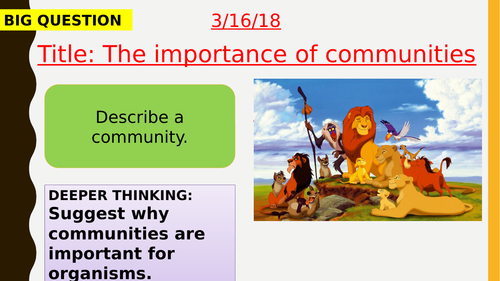
The importance of communities lesson created in accordance to the NEW AQA Specification (9-1). Designed for a higher ability class, although content can be adjusted to suit any ability. Includes powerpoint timers, slide animations, embedded video’s and mini review. NB: If you are unable to play embedded videos please view slide notes for link.
AQA spec link: 4.7.1.1
Relevant chapter: B15 Adaptations, interdependence and competitions. AQA Biology combined edition textbook-Page 206-207
Students are required to know the following;
Students should be able to describe: •different levels of organisation in an ecosystem from individual organisms to the whole ecosystem • the importance of interdependence and competition in a community.
An ecosystem is the interaction of a community of living organisms (biotic) with the non-living (abiotic) parts of their environment. To survive and reproduce, organisms require a supply of materials from their surroundings and from the other living organisms there. Plants in a community or habitat often compete with each other for light and space, and for water and mineral ions from the soil. Animals often compete with each other for food, mates and territory. Within a community each species depends on other species for food, shelter, pollination, seed dispersal etc. If one species is removed it can affect the whole community. This is called interdependence. A stable community is one where all the species and environmental factors are in balance so that population sizes remain fairly constant.
Get this resource as part of a bundle and save up to 35%
A bundle is a package of resources grouped together to teach a particular topic, or a series of lessons, in one place.
Something went wrong, please try again later.
Report this resourceto let us know if it violates our terms and conditions.
Our customer service team will review your report and will be in touch.
